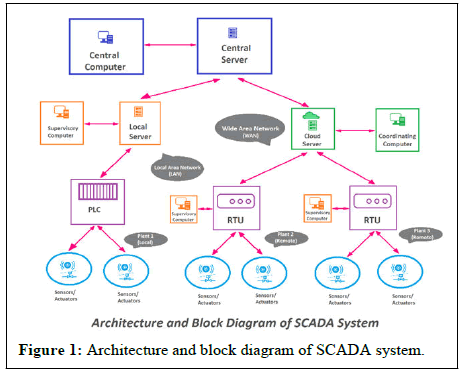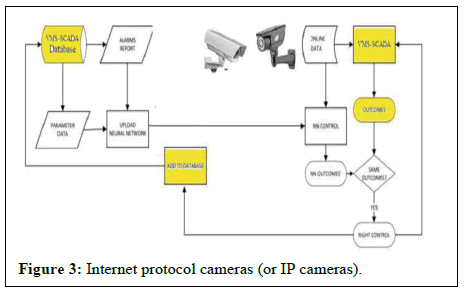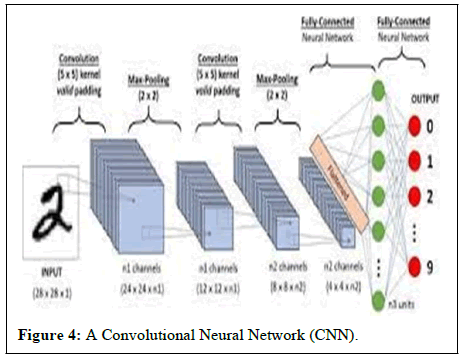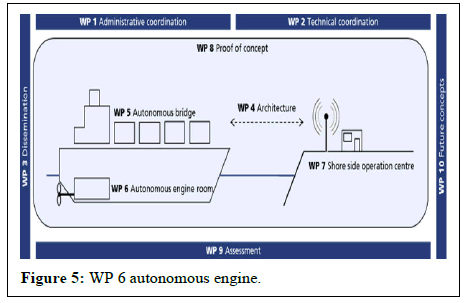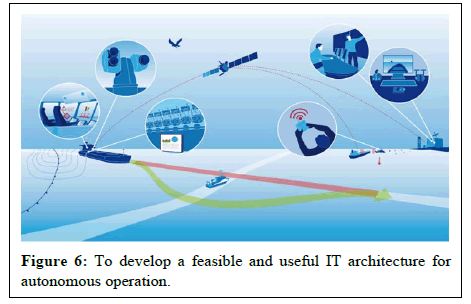Situational Awareness by Simulators for Engine Control Room Integrated Alarm Monitoring System for Maritime Autonomous Ships
Received: 06-May-2023 / Manuscript No. JMSRD-23-97943 / Editor assigned: 09-May-2023 / PreQC No. JMSRD-23-97943 (PQ) / Reviewed: 25-May-2023 / QC No. JMSRD-23-97943 / Revised: 03-Jan-2024 / Manuscript No. JMSRD-23-97943 (R) / Published Date: 10-Jan-2024
Abstract
Automation advancement, artificial intelligence and human interaction with AI is need of shipping to upgrade manned or Unmanned Ships (UMS) with crew onboard to upgrade it to autonomous ships with various degrees(refer to MASS for various degrees) to avoid implications of human factors and save human and marine life at sea. However, the implementation of AI technologies may also jeopardize safety if trained and skilled remote control operators are not in the active role above and beyond a backup of autonomous ships. Various research studies and real time scenarios concluded “Human centered artificial intelligence”, which aims to improve AI based systems design by jointly increasing human and machine control to achieve “safe, reliable and trustworthy” systems. Interaction with AI will result in a higher mental workload among seafarers and RCC (Remote Control Center) operators if proper exposure to AI is not provided. Training RCC and seafarers for autonomous ships requires a large amount of historical data and building test prototypes and operating them in controlled areas. This is expensive for any ship owner and flag state to implement it. Hence virtual simulation is the only solution for it. Utilization of SCADA to control the entire engine room machinery which is connected with PLC and a network of surveillance IP cameras. Therefore, the video data are acquired from IP cameras, stored and processed, and then transmitted and remotely controlled via SCADA. SCADA based VMS programs can easily incubate AI and deep ML algorithms. The harmonic utilization of Neural Network Algorithms (NNA) in the software core will lead to unprecedented performance in terms of motion detection speed and other smart analytics as well as system availability. Simulator experiments will help to assess and evaluate the role of human-machine interactions and also benefits training and evaluating seafarers and RCC operators without resource intensive field testing.
Keywords
UMS unmanned ship; MASS Maritime autonomous surface ships; RCC remote control center; SCADA supervisory control and data acquisition; VMS video management system; NNA neural network analysis
Introduction
Autonomous ships could reduce human error, decrease crewing costs, increase the safety of aquatic life and increase fuel efficiency. According to the International Chamber of Shipping (ICS), A three year research project by MUNIN (Maritime Unmanned Navigation through Intelligence in Networks) predicted a saving of over $7 m over a 25 years period per autonomous vessel in fuel consumption and crew supplies and salaries. Maritime vessels constitute 90% of all international trade, therefore autonomous innovation in shipping could revolutionize the sustainability and efficiency of the trade [1]. Automation and digitalization have been increasingly adopted in the maritime transportation sector, yet, the introduction of Maritime Autonomous Surface Ships (MASS) into commercial shipping remains a challenging and uncertain concept. In order to assess the scope of differing levels of autonomous ships, IMO defined four degrees of autonomy. The lowest degree of autonomy involves automated processes that can control the ship at times. Seafarers will remain in charge of operating and controlling the ship when the automated system is not activated. The second degree is a remotely controlled ship with seafarers still on board. The ship will be controlled from another location but the seafarers on board will be able to take control if necessary. The next degree is a remotely controlled ship without any seafarers on board. Lastly, the highest degree of autonomy is a fully autonomous, unmanned ship that is equipped with the ability to make decisions and take action by itself. However, it is impossible to make all ships autonomous with immediate effect. We need to do it in a phased manner [2]. Autonomous navigation requires a strong foundation of big data from AIS (Automatic Identification System), weather forecasts, and real time data from integrated bridge navigation equipment and Artificial Intelligence (AI) and data collection to create an awareness system that predicts hazards, alerting operators of impending collisions. Here our focus is to develop an integrated autonomous engine room automation system for all machinery which must be stable and cyber secure, to national and international rules and regulations.
Materials and Methods
SCADA
Supervisory Control and Data Acquisition (SCADA) is a software overlay application, which is used on top of intelligent control networks. SCADA systems evolved rapidly and penetrated reliability into the operation of modern ships’ integrated automation systems (Kongsberg) [3]. SCADA systems have made substantial progress over the recent years to increase their functionality, scalability, performance and openness. SCADA based cyber physical systems not only collect data but are able to connect with devices and applications, systems, and other real time software for a continuous exchange of updated and always available information, at all times (Figure 1). The main components of a SCADA system are as follows:
• Multiple Remote Terminal Units (RTUs) or Smart sensors or PLCs.
• Master Station and Human Machine Interface (HMI) Computer(s).
Communication infrastructure. It is possible to purchase a SCADA system from a single supplier or tailor a SCADA system from different manufacturers, such as Siemens and Allen Bradley PLCs. exploit SCADA programs to implement a wide area Video Management Systems (VMS), which incorporate state-of-the-art AI technologies, such as access control, intrusion detection, face recognition and parameter reading from all ship machinery. Remote control centers and monitoring stations use diverse types of cameras and sets of technology to monitor and control integrated alarm monitoring and control systems. Fortunately, SCADA architecture supports TCP/IP (Internet Protocol), UDP, or other IP based communications protocols, which makes it ideal for video surveillance control with a network of IP cameras. MQTT is favored ahead of HTTP and CoAP because of its unique features like support for constrained resources such as low bandwidth and it can be implemented over various TCP/IP connectivity [4]. In addition, Things Board server nodes act as an MQTT Broker that supports QoS levels 0 (at most once) and 1 (at least once), and a set of predefined topics which means that an external device that can be configured as an MQTT Client to publish data to the server nodes.
SCADA based video surveillance system
SCADA systems is that it allows operators to visualize, in realtime, what is happening in any particular industrial process, react to alarms, control processes, change configurations, and track information in real time. SCADA system covers much larger areas. Similarly, wide area video monitoring requires large scale monitoring systems, like those of SCADA networks [5]. Remote central monitoring stations use diverse types of cameras and sets of technology to monitor and control the integrated SCADA onboard ships. SCADA architecture supports TCP/IP (Internet Protocol), UDP, or other IP-based communications protocols, which makes it ideal for video surveillance control with a network of IP cameras (Figure 2).
VMS integrated SCADA with NNA
Internet Protocol cameras (or IP cameras), as they are usually referred to, bring together all the power of video surveillance combined with the capabilities of the Internet. The main strength of using AI with IP cameras is their capacity to learn from new situations and identify unseen issues or problems [6]. Pairing IP cameras with artificial intelligence will help further the goal of having a true autonomous colleague, that helps us elevate everything we do. Apart from its incredible self-learning capabilities, AI can also detect, decide and respond to a specific situation to achieve a particular goal. It is constantly learning and improving. Error is minimized with every iteration, leaving human flaws behind (Figure 3).
The employed NNA aims to improve the control of the system by using an iterative supervised process. The objective is to determine and optimize the SCADA-VMS control parameters for specific sites with specific surveillance devices. The chosen parameters, such as the favorite angles of PTZ cameras, the detection speed (of motion anomalies), and false arm sources, will help to increase surveillance performance and system availability. In addition, the optimized system will minimize false alarms in a continuous adaptive manner, according to each site-specific equipment. Actually, the NNA is based on finding differences in the behavior of the surveillance system over time [7]. The iterative process starts with a database of the stored SCADACitation VMS database, as shown in Figure 3. The SCADA based VMS programs, with NNA, can help in this context and can easily incorporate the following features and intelligent analytics.
Results and Discussion
Deep learning based video surveillance solutions
In deep learning, a Convolutional Neural Network (CNN) is a sort of NNs; which is particularly useful in video surveillance projects. The advantage of Deep Learning (DL) based algorithms with respect to legacy computer vision algorithms is that DL systems can be continuously trained and improved with updated datasets [8]. In DL, a Convolutional Neural Network (CNN) is a type of NN, commonly used in image recognition and processing, with emphasis on machine vision of images and video. As shown in Figure 4, the layers of a CNN consist of an input layer, an output layer and a hidden layer that includes multiple convolutional layers, pooling layers, fully connected layers, and normalization layers. Deep learning systems have shown a remarkable ability to detect undefined or unexpected events. This feature has the true potential of significantly reducing false alarm events that happen in many securities video analytics systems. Many applications have shown that deep learning systems can-learn to achieve 99.9% accuracy for certain tasks, in contrast to rigid computer algorithms where it is very difficult to improve a system past 95% accuracy [9].
Overview of this project
Our focus is on WP 6 autonomous engine room and aims to develop an integrated and appropriate concept for autonomous operations of the technical system of the ship, particularly the ship’s engine (Figure 5).
Here of the central scientific and technical parts of the project are to develop a feasible and useful IT architecture for autonomous operation, analyze and develop a concept for autonomous operation of the engine room, define the processes in a shore side operation center required to enable a remote control of the vessel, validate the feasibility of the developed solutions combined into the concept of an autonomous and unmanned vessel (Figure 6) [10].
Conclusion
This chapter presents a method based on Neural Networks (NN) for monitoring and operating Video Surveillance Systems (VMS), like those in traffic control networks of electronic plaza sites. The method suggests that the thresholds used for generating alarms can be adapted to each surveillance device (e.g., IP Camera). The industry needs to do more research on hybrid systems that combine the best of SCADA and AI algorithms together with VMS software. Security and video surveillance need continuous change with time, to cope with the new hardware capabilities of IP cameras and video storage equipment. In addition, the increasing need for video analytics is required in modern VMS software, to perform their job of monitoring activities and protecting humans, and ocean life and energy saving. Industry 4.0 is a fundamental driver of innovation in the marine industry, where the new digital era will see the development of smart cyber ships equipped with advanced automation systems that will progressively evolve toward fully autonomous vessels. Although the journey towards such a technological frontier has started, most companies operating in the maritime sector still appear unprepared to face the future scenario. When tools like big data and IoT are used to drive autonomous vessels, cybersecurity is a major concern. Strong security to ensure that the control algorithms are not tampered with and the safety of the boat or the goods it carries is not compromised is important. When it comes to automation, taking things halfway cannot be a solution. Using technology for assistance and creating a technology dominant operational workflow are very different things. For instance, if boats are made autonomous, but ports remain manually operated, the point of automation is lost.
Acknowledgements
The authors thank Mr. Hans Anton Tvete, Programme Director, Maritime at DNV for his initial guidance and requirement for autonomous ships. And thanks to KOTC shipping for support, Also, the authors thank the International Research Centre of Kalasalingam Academy of Research and Education, Tamil Nadu, India for permitting me to use the Library and Dr. Vijayakumar’s support and guidance.
References
- IMO Maritime Safety Committee (2018) Annex 2 Framework for the Regulatory Scoping Exercise for the Use of Maritime Autonomous Surface Ships (MASS). London.
- IMO (2021) Maritime Safety Committee, Outcome of the Regulatory Scoping Excercise for the use of Maritime Autonomous Surface Ships. London.
- United nations conference on trade and development (2022) Review of maritime transport 2021. United Nations Publications. New York, United States of America.
- Chen L, Huang Y, Zheng H, Hopman H, Negenborn R (2019) Cooperative multi-vessel systems in urban waterway networks. IEEE Trans Intell Transp Syst 21: 3294-3307.
- Wan S, Xu X, Wang T, Gu Z (2020) An intelligent video analysis method for abnormal event detection in intelligent transportation systems. IEEE Trans Intell Transp Syst 22: 4487-4495.
- El-Saba MH (2017) Supervisory Control and Data Acquisition (SCADA). Measurement and Instrumentation Systems, Publisher: Hakim. [Crossref] [Google Scholar] [PubMed]
- Marugan AP, Marquez FG (2017) SCADA and Artificial Neural Networks for Maintenance Management. In: international conference on management science and engineering management. Springer, Cham, 912-919.
- Jang GS, Suh SM, Kim SK, Suh YS, Park JY (2013) A proactive alarm reduction method and its human factors validation test for a main control room for SMART. Ann Nucl Energy 51: 125-134.
- Chen R, Connelly RR, Mantel N (1993) Analysing post‐alarm data in a monitoring system in order to accept or reject the alarm. Stat Med 12: 1807-1812.
[Crossref] [Google Scholar] [PubMed]
- Fu R, Wang S, Wang S (2017) Real-time alarm monitoring system for detecting driver fatigue in wireless areas. Promet-Traffic Transport 29: 165-174.
Citation: Pandi PM (2024) Situational Awareness by Simulators for Engine Control Room Integrated Alarm Monitoring System for Maritime Autonomous Ships. J Marine Sci Res Dev 14: 425.
Copyright: © 2024 Pandi PM, et al. This is an open-access article distributed under the terms of the Creative Commons Attribution License, which permits unrestricted use, distribution and reproduction in any medium, provided the original author and source are credited.
Select your language of interest to view the total content in your interested language
Share This Article
Recommended Journals
Open Access Journals
Article Usage
- Total views: 1619
- [From(publication date): 0-2024 - Nov 08, 2025]
- Breakdown by view type
- HTML page views: 1291
- PDF downloads: 328

